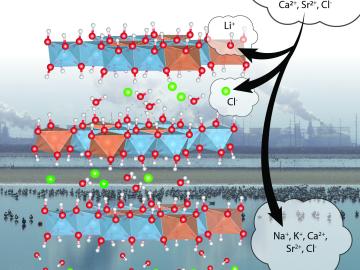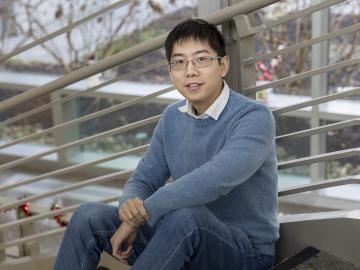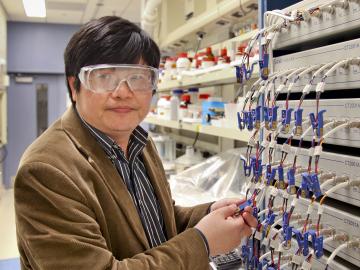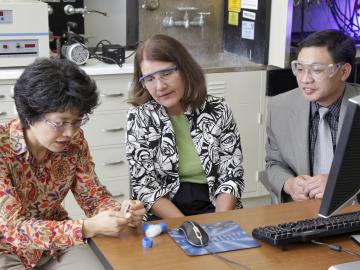
Filter News
Area of Research
- (-) Biology and Environment (17)
- (-) Materials (89)
- Advanced Manufacturing (7)
- Biological Systems (3)
- Biology and Soft Matter (1)
- Building Technologies (2)
- Chemical and Engineering Materials (2)
- Chemistry and Physics at Interfaces (6)
- Clean Energy (110)
- Climate and Environmental Systems (2)
- Computational Chemistry (1)
- Computer Science (2)
- Energy Frontier Research Centers (7)
- Energy Sciences (1)
- Functional Materials for Energy (6)
- Fusion and Fission (5)
- Fusion Energy (6)
- Geographic Information Science and Technology (2)
- Isotope Development and Production (1)
- Isotopes (4)
- Materials for Computing (5)
- Materials Synthesis from Atoms to Systems (5)
- Materials Under Extremes (6)
- National Security (12)
- Neutron Data Analysis and Visualization (2)
- Neutron Science (37)
- Nuclear Science and Technology (28)
- Nuclear Systems Modeling, Simulation and Validation (2)
- Quantum Condensed Matter (2)
- Quantum information Science (3)
- Reactor Technology (1)
- Supercomputing (58)
- Transportation Systems (2)
News Type
News Topics
- 3-D Printing/Advanced Manufacturing (5)
- Advanced Reactors (1)
- Artificial Intelligence (2)
- Big Data (3)
- Bioenergy (4)
- Biology (4)
- Biomedical (7)
- Biotechnology (1)
- Chemical Sciences (2)
- Clean Water (1)
- Climate Change (4)
- Computer Science (12)
- Coronavirus (7)
- Critical Materials (3)
- Cybersecurity (1)
- Energy Storage (8)
- Environment (9)
- Exascale Computing (1)
- High-Performance Computing (1)
- Isotopes (1)
- Machine Learning (3)
- Materials (2)
- Materials Science (30)
- Mathematics (1)
- Mercury (1)
- Microscopy (5)
- Molten Salt (1)
- Nanotechnology (13)
- National Security (1)
- Neutron Science (11)
- Nuclear Energy (3)
- Physics (8)
- Polymers (4)
- Quantum Science (4)
- Security (1)
- Summit (5)
- Sustainable Energy (6)
- Transformational Challenge Reactor (2)
- Transportation (3)
Media Contacts

In the quest for domestic sources of lithium to meet growing demand for battery production, scientists at ORNL are advancing a sorbent that can be used to more efficiently recover the material from brine wastes at geothermal power plants.

Scientists at have experimentally demonstrated a novel cryogenic, or low temperature, memory cell circuit design based on coupled arrays of Josephson junctions, a technology that may be faster and more energy efficient than existing memory devices.

Eugene P. Wigner Fellow Victor Fung’s story is proof that a series of positive experiences around science and happy accidents can lead to a rewarding research career. He joined ORNL in 2019.

Researchers at ORNL have developed a quantum chemistry simulation benchmark to evaluate the performance of quantum devices and guide the development of applications for future quantum computers.

Sheng Dai of the Department of Energy’s Oak Ridge National Laboratory has been named to a list of the most highly cited researchers in the world. Thomson Reuters Highly Cited Researchers is an annual list that recognizes some of the world’s leading


The Department of Energy's Oak Ridge National Laboratory and Solid Power Inc. of Louisville, Colo., have signed an exclusive agreement licensing lithium-sulfur materials for next-generation batteries. The company licensed a portfolio of ORNL patents relating to lit...


Researchers at the Department of Energy’s Oak Ridge National Laboratory have received six R&D 100 Awards, increasing the lab’s total to 193 since the award’s inception in 1963. The competition, sponsored by R&D Magazine, recognizes advances in the nation’s ...

The Department of Energy’s Oak Ridge National Laboratory, FCA US LLC, and the foundry giant, Nemak of Mexico, are combining their strengths to create lightweight powertrain materials that will help the auto industry speed past the technological


